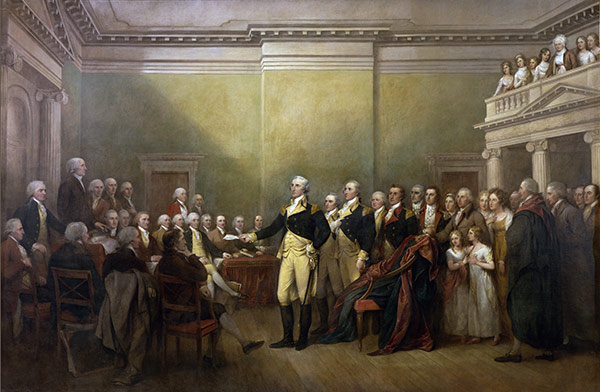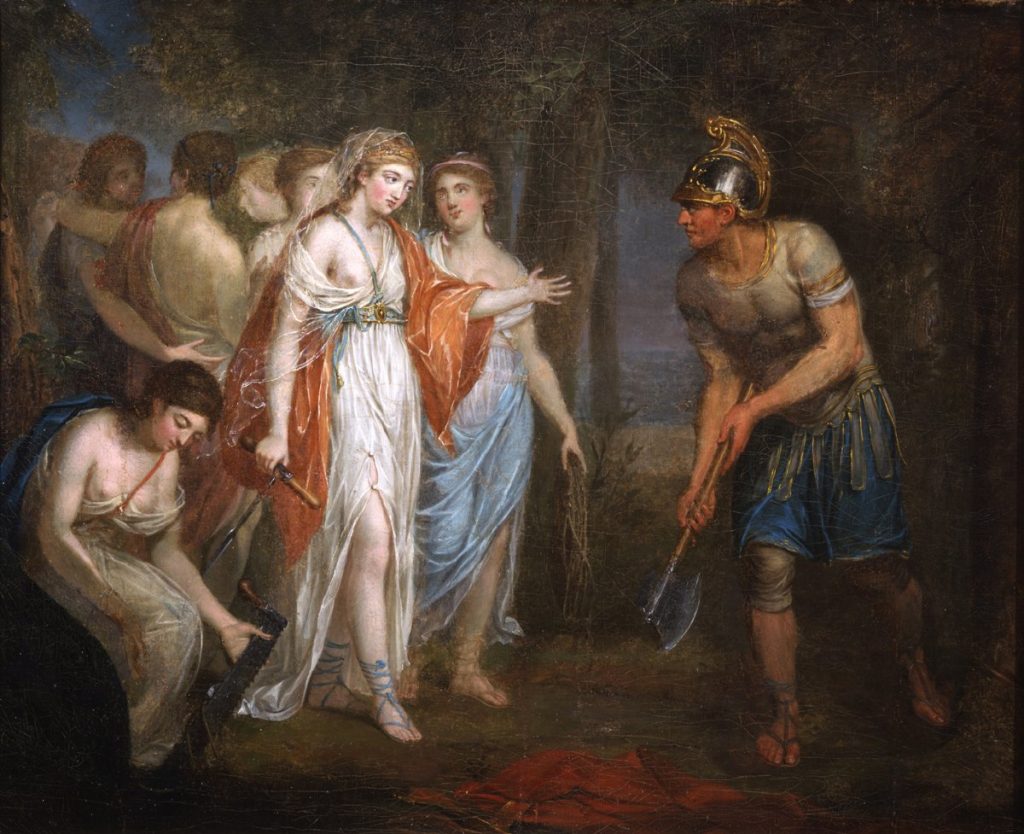Jeff Lowe, The Molly Ockett School, Fryeburg, Maine
DESIGN LEVEL: Middle School-High School
Overview
“Revolutionary writers and orators frequently made parallels between Rome and America. Josiah Quincy compared the tyrant Caesar to King George, asking, Is not Britain to America what Caesar was to Rome? One of the most dramatic and obvious examples is Joseph Warren’s oration on the Boston Massacre in 1775, during which he wore a Roman toga. It would be difficult to find any public figure of the Revolutionary period who did not quote a classical author in their pamphlets, orations, or letters.” [Paul Meaney, 2018]
This lesson asks students to analyze visual and written primary sources to understand the influence of classical history on the men and women who created our republic and the unique role of America’s Cincinnatus, George Washington.
Objectives
Students will use a variety of sources to:
- identify the influence of classical history on America’s founders,
- analyze the republican example set by America’s first president,
- activate prior knowledge from lessons about America’s founding, George Washington’s Farewell Address, civilian control of the military and the lives of George Washington and other military leaders.
Materials
- The Return of Cincinnatus, attributed to Angelica Kauffmann, ca. 1775, The Society of the Cincinnati
- General George Washington Resigning His Commission, John Trumbull, 1826, United States Capitol Rotunda
- YouTube Video Clip: “One Last Time” from Hamilton: An American Musical, Hamilton At The White House
- George Washington to the Marquis de Lafayette, Sunday, February 01, 1784, Mount Vernon, The Washington Library Center for Digital History
- “From George Washington to Lafayette, 1 February 1784,” Founders Online, National Archives, https://founders.archives.gov/documents/Washington/04-01-02-0064. [Original source: The Papers of George Washington, Confederation Series, vol. 1, 1 January 1784 – 17 July 1784, ed. W. W. Abbot. Charlottesville: University Press of Virginia, 1992, pp. 87–90.]
- Mr. Lowe’s Fig and Vine Google Slides
- Mr. Lowe’s Fig and Vine EDpuzzle
Recommended Time
20-30 minutes
Activity
Working individually or in pairs students will:
Read the letter from George Washington to the Marquis de Lafayette and answer the following questions:
- Who wrote the document?
- Who received the document?
- What is the topic?
- When was it created?
- Why do you believe this document is important?
Examine The Return of Cincinnatus using a jigsaw/aim-small art interpretation method (like that facilitated by Mr. Lowe’s Fig and Vine EDpuzzle) and answer the following questions:
- What do you see? Be descriptive.
- When do you believe this image is set?
- What evidence do you have to support your ideas?
Ask students to share their discoveries.
Discuss the life of Lucius Quinctius Cincinnatus using the short biography on the the Society of the Cincinnati website at https://www.societyofthecincinnati.org/society-of-the-cincinnati-name/.
Ask students to listen to a sample of the song “One Last Time” from Hamilton: An American Musical and then to apply the imagery of the song to the imagery in The Return of Cincinnatus to craft a single question using each of the following interrogative adverbs: Who? Where? What? When? How? and Why? Provide an appropriate answer for each.
Discuss the background information from Mr. Lowe’s Google Slides about the American Cincinnatus, George Washington:
Depictions of Washington as Cincinnatus abounded in the Revolutionary and Early Republican periods. Philip Freneau evoked Cincinnatus in a poem written on the occasion of Washington’s resignation in December 1783. Remarking on Washington’s decision to return to retirement at Mount Vernon, Freneau wrote: “Thus He, whom Rome’s proud legions sway’d/Beturn’d, and sought his sylvan shade.” Thirty years later, in his “Ode to Napoleon,” Lord Byron eulogized Washington as “the Cincinnatus of the West.” In one of the most famous contemporary images of Washington, Jean-Antoine Houdon’s statue (1785-1791) in the rotunda of the state capitol in Richmond, Virginia, the retired general is portrayed in civilian dress as “a modern Cincinnatus,” standing in front of his plow.
Analyze John Trumbull’s General George Washington Resigning His Commission.
Using the two images, The Return of Cincinnatus and General George Washington Resigns His Commission ask students to complete the following challenges:
- As an art historian, identify 2-3 similarities that the artists used to illustrate what both of the central characters anticipated by retiring from public life.
- As a political historian, using the images, letter to Lafayette and the music, explain why you believe Cincinnatus was an role model for George Washington.
- As an American citizen, describe the effect of Cincinnatus’ influence as a role model on George Washington and on our republican system of government.
Assessment
Instructors should consider a student’s time on task, attempts at task and how they report-out the results of the task challenge.
Standards Addressed
COMMON CORE: English Language Arts Standards—History/Social Studies—Grade 6-8
Historical Analysis and Skills Development: Reading, Writing, Speaking, Listening; Writing: Key Ideas and Details; Craft and Structure: Integration of Knowledge and Ideas
MAINE LEARNING RESULTS FOR SOCIAL STUDIES (HISTORY)—REVISED 2019
History 1: Students understand major eras, major enduring themes, and historic influences in the history of Maine, the United States, and various regions of the world by:
(F1) Explaining that history includes the study of past human experience based on available evidence from a variety of primary and secondary sources; and explaining how history can help one better understand and make informed decisions about the present and future.
(F3) Tracing the history of democratic ideals and constitutional principles and their importance in the history of the United States and the world.
History 1: Students understand major eras, major enduring themes, and historic influences in United States and world history, including the roots of democratic philosophy, ideals, and institutions in the world by:
(D3) Tracing and critiquing the roots and evolution of democratic ideals and constitutional principles in the history of the world using historical sources.
(F3) Tracing and critiquing the roots and evolution of democratic ideals and constitutional principles in the history of the United States using historical sources.
